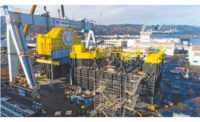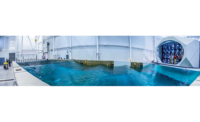Wave energy, the emerging renewable resource behind wind and solar, is gaining traction as innovators advance the technology of wave-energy converter devices.
For a U.S. Dept. of Energy design-build competition that drew 92 submissions, the judges on Nov. 16 selected one such device, which started as a garage project, for the $1.5-million top prize. The judges awarded two other submissions $500,000 and $250,000, respectively.
The competition’s first stage involved testing and numerically modeling 1:50-scale models. The nine finalists received up to $125,000 in seed funding to build and test a 1:20-scale model at the Naval Surface Warfare Center’s Maneuvering and Seakeeping Basin, in Carderock, Md.
Four teams, including the top winner, went well beyond the DOE’s challenge of doubling the energy capture of earlier designs, applying metrics achieved in 2014, when a drive was launched to stimulate design development of wave-energy converters, according to DOE.
The top award went to Aquaharmonics for an “ocean-power point absorber,” created by mechanical engineer Alex Hagmüller and electrical engineer Max Ginsburg, both of Portland, Ore.
Robert Thresher, one of the judges and a mechanical engineering research fellow at the National Renewable Lab, Golden, Colo., says the Aquaharmonics device won due to its ability to maximize energy capture and minimize cost while behaving well in the water and surviving larger waves. “The cable-drive device is a simple, lightweight structure with a control system that allows the generator to resist the wave motion with exactly the right resistance for the wave,” Thresher says. “Getting the control right was their magic sauce.”
Alison Labonte, DOE program manager for marine and hydrokinetic technology, says, “They did something nobody has been able to accomplish before.”
Ginsburg’s controls constantly tune the mechanism of the energy-absorbing buoy to the highly variable rise and fall of ocean waves, a capability considered a major breakthrough for the early-stage industry.
The Aquaharmonics converter specifies a carbon-fiber, cylindrical hull with conical ends. At full scale, it would have a 50-ft diameter and weigh 165 tons.
Hagmüller says, “The maximum average electrical output is extremely dependent on wave climate” but would deliver 700 kW in a 5-meter sea state.
The device, which Hagmüller calls “a glorified winch,” is anchored by a cable that winds and unwinds a generator in the buoy. Software constantly updates the torque in response to incoming wave data, allowing the generator to produce power as it reels out the mooring line on a wave’s rise and to consume less power recovering cable on the wave’s fall. Each rise-and-fall cycle delivers “a net-average power increase over just passively damping the waves,” Hagmüller says.
The DOE used a formula called ACE, a benefit-to-cost ratio, to compare the finalists’ models at their relatively low level of development. ACE is determined by dividing a converter’s energy-capture efficiency by its cost.
Wave energy is the U.S.’s largest marine and hydrokinetics resource, with roughly 1000 terawatt hours per year of potential, says Labonte. “Each terawatt hour is enough to power 90,000 homes. If we extract 5% of the technical resource potential, we could ultimately deliver electricity to 5 million American homes.”
One distinct advantage of wave energy is constancy. “As a renewable, it’s always on. With solar, the sun goes down, and wind can stop blowing,” Labonte says.
Thresher says the competition ran 1:50-scale and 1:20-scale tank tests at five facilities and generated regular sinusoidal waves and then irregular waves to simulate typical sea states off the West Coast. Energy capturing typically worked best with 1-m to 5-m waves, he says.
Hagmüller, 34, and Ginsburg, 30, met as roommates at Oregon State University, Corvallis, in 2008. For four years after high school, Hagmüller, a tinkerer, worked as a motorcycle mechanic, a diesel mechanic for the Alaska fishing industry, and as a boat fabricator and welder. A math whiz, Ginsburg went straight to college.
After he graduated from college, Hagmüller first toyed with the idea of building a wave-energy converter while working as an engineer on the Port Mann Bridge project in Vancouver. “In the early morning hours, I would go out to the shop and tinker with what was laying around—a Roomba vacuum cleaner, bicycle parts and inner tubes—to get a feel for how it would work.”
He soon had a prototype. He began emailing Ginsburg, then working for the Navy on submarines in Pearl Harbor, with questions about challenges such as building a circuit to accommodate the irregular input of wave energy.
In 2011, they met on the Oregon coast to test their fourth design before crowds of gawking beachgoers. Then, to collaborate better, both relocated to Portland.
The first promising design cost $300, but they needed $50,000 for tank testing to improve the output, Hagmüller says. Unable to attract interest in their invention, which “didn’t look pretty or refined,” they nearly lost hope, Hagmüller recalls. But with the help of an OSU alumnus who offered to do 3D printing for the $400 materials cost, they built their first real prototype.
The inventors were among the first to enter the DOE competition. Still using their own funds, Hagmüller and Ginsburg started from scratch, redesigning and building their 1:50-scale model, before winning the $125,000 seed funding as finalists.
Thresher says the Aquaharmonics submission had the advantage of a simple structural design, which gave its creators time for refinement, but notes that there were other, more complex designs that also demonstrated good ideas.
CalWave Power Technologies, Berkeley, Calif., won $500,000 with a fully submerged pressure-differential device, developed by an eight-member team led by Marcus Lehman. Submerged systems can be less vulnerable to storms. Lehman says the CalWave device can effectively shut down during extreme conditions.
In 2012, while studying for his master’s degree at the University of California at Berkeley, Lehman built a prototype of the system. It is based on his mechanical engineering professor’s concept. The year after the concept was accepted, Cyclotron Road, a technology incubator at Lawrence Berkeley National Laboratory, assisted in its development.
“We entered the DOE competition as a parallel effort, advancing the initial shallow-water design to a deepwater one to meet the competition requirements of 120-meter water depth,” Lehman says.
The $250,000 prize went to Waveswing America’s pressure-differential point-absorber, another fully submerged device. The technology is owned by Simon Grey, CEO at AWS Ocean Energy, Scotland. Its direct-drive system comprises an air-filled chamber that is fixed to the seabed, says Mirko Previsic, owner of ReVision Consulting, Sacramento, and Waveswing team leader. Open at the top, the device is closed at the bottom by a cylindrical floater that rises and falls as pressure increases or decreases from the waves passing overhead. The movement drives a power take-off in the middle. “The relative motion between the top shelf and the bottom shelf as it moves is converted into electricity,” Previsic says.
“We’re on a path to follow the same model of cost reduction [as wind and solar] with investments we’re making,” Labonte says. She predicts that, within five years, wave energy could be competitive with diesel in remote coastal markets.









Post a comment to this article
Report Abusive Comment